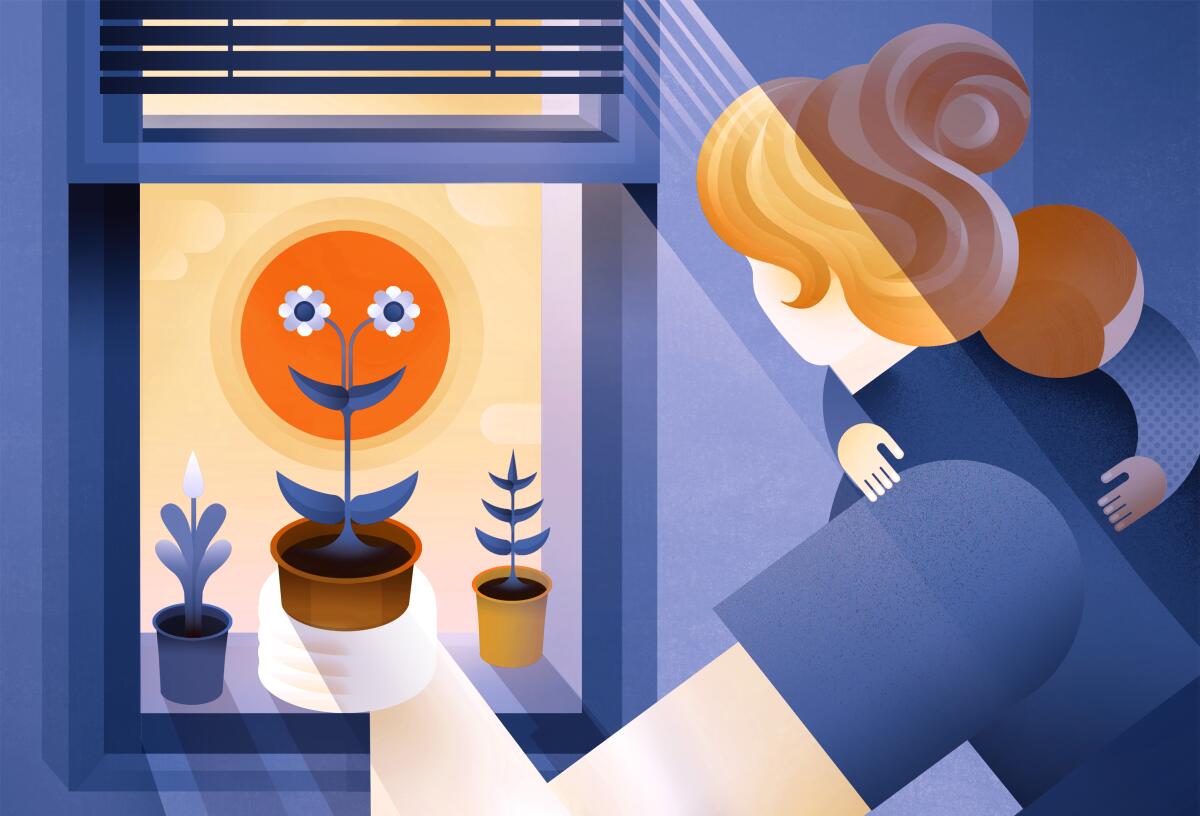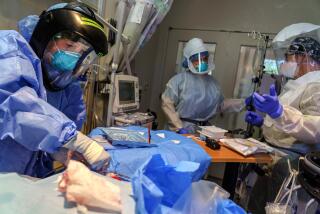I’m the mother of a toddler. This is why I no longer live in fear.

In this time of tremendous uncertainty, many of you might be turning to books such as “The Power of Now” or “The Miracle of Mindfulness,” both of which preach the importance of living in the moment. I’m no Eckhart Tolle or Thich Nhat Hanh, but I am the mother of a 20-month-old with a terminal disease.
The moment is all I have.
Many Californians panicked last month when Gov. Gavin Newsom announced a stay-at-home order, accompanied by news that 56% of us could contract the coronavirus within eight weeks. At the time, that was a worst-case scenario.
Unfortunately, panic and helplessness have become familiar foes of mine since my daughter, Evan, was diagnosed with a rare mitochondrial disorder at 4 months. Her diagnosis came without warning. I had a great pregnancy — with genetic testing, an amniocentesis and every prenatal screening under the sun. I took my vitamins, exercised, ate well and embraced green juices. (Avocado was the thing I craved most.) The truth was: I loved being pregnant. People were nice. After interviewing Gwyneth Paltrow, she told me: “You look great. You look like you swallowed a basketball. I was a mess when I was pregnant.” She wasn’t, but the compliment buoyed my spirits.
Life as a career-obsessed entertainment journalist had been a cosseted existence filled with the facade of red carpets and couture gowns. An incurable disease with little to no research behind it wasn’t the sort of thing that was supposed to happen to us. This was the sort of thing you read about happening to “other people,” and yet there I was — in a children’s hospital room with butterflies on the ceiling — being told my daughter would likely never walk and never talk and that, at best, she would have a “low IQ.” And she could very possibly lose her eyesight down the line in addition to being born deaf.
My perception of what being a first-time mother should look like came to a screeching halt. Evan was poked by a phlebotomist nine times a day. Each time that she cried out for help that I couldn’t provide, a piece of my soul chipped away. I worried she would never know anything other than pain and suffering. I feared I would never feel joy again. I worried. I feared. I anticipated. I waited for the unknown to unfold.
I felt like I was trapped in an indie movie — the kind that gets nominated for an Oscar but one I would never actually want to watch. I tried to remind myself, “By the time I recognize this moment / this moment will be gone” — the words of my favorite philosopher, singer John Mayer.
After a nearly two-month stay, we were discharged from the hospital when my daughter was 6 months old. We were given the news that other children with her condition typically die between the ages of 16 months and 4 years. We left with a $500,000 hospital bill and the medical advice to “live one day at a time.”
My husband and I learned to give emergency shots, feed our daughter through a gastrostomy tube and administer more than a handful of medications four times a day after running around town to four pharmacies. This also meant juggling nonstop doctor’s appointments and a therapy schedule that would overwhelm any celebrity’s personal assistant. Initially the circumstances felt insurmountable, and sometimes they still do — and yet we adapted. We focused on the tasks at hand and stopped looking ahead.
As time passed, we found that between moments of darkness there is light if you search for it. My family learned to disregard traditional developmental milestones in favor of embracing my daughter’s version of normal. Evan’s achievements included every additional 10 milliliters of Gerber food she learned to consume and every new way we found to make her laugh. With each smirk, giggle or squeal, a piece of my soul returned. Her smile became our caffeine.
We spent time with family and friends, who may not have understood what we going through but who stood by us so we felt a little less alone. My husband and I carved out moments for self-care as best we could. In my husband’s case, it was CrossFit; I turned to writing and having coffee with girlfriends.
We threw the past and future into the ether to focus on the present. We slowed down and learned to savor the simple things: the happiness found in a daily cup of coffee, the sun shining during a neighborhood stroll, and a pair of cheerful sunglasses our daughter loves wearing and that make strangers chuckle.
Our daily mission became this question: “How do we make today the happiest day of our daughter’s life?”
Therefore, I challenge all of you to do the same right now. In this time of anxiety and isolation, hand washing and stocks tumbling, how can you make today the happiest day possible?
The coronavirus affects each of us, and because of this crisis, I can relate to how other people are feeling for the first time in a long time. I understand the frustrations and the fear of what tomorrow might bring; the terror of financial ruin because of mounting medical bills; and the worry of losing a job and career you’ve worked so hard to achieve — and most important, on which you rely for health insurance — all because of circumstances outside your control. Those “what ifs” keep everyone up at night. All you can do is manage them.
Take comfort in the fact you’re not alone. We’re all afraid. We’re all coming to terms with a new way of life — one that may be temporary but that will forever change us. Use this time as a means of becoming the best version of yourself. You never know your own strength until you’re forced to discover it. This is the time for self-discovery. You’re being tested. For those who are more fortunate, do what you can to help your community. For those who need help, don’t be afraid to ask for it. Keep putting one foot in front of the other and move forward — even if it’s within the confines of your home or apartment.
Find joy in each breath you take. Each birthday you have. Every wrinkle you’ve earned. My family learned this lesson the hard way, but we’re appreciative now more than ever. We’ve learned gratitude in the form of so many things that we might otherwise take for granted.
Thanks to a cochlear implant surgery, my daughter can hear, and she’s learned to love music. Every night when the clock strikes 6, right after we blow bubbles but before her bath, book and bedtime, my husband and I hold Evan close to our hearts, play music and dance.
Lizzo’s “Good as Hell,” Taylor Swift’s “Shake It Off” and DJ Khaled’s “All I Do Is Win” pump her up when she has the energy for it. Mayer’s covers of “Free Fallin’” by Tom Petty and “XO” by Beyoncé are her favorite songs for unwinding. Each night, Mayer croons Beyoncé’s lines: “We don’t have forever / Ooh, baby, daylight’s wasting / You better kiss me / Before our time has run out ...”
We sing. We sway. And we hold our daughter tight, because while we don’t know what the next day will bring, we do know we have her here and now.
Lindzi Scharf is a freelance entertainment writer whose stories have appeared in the Los Angeles Times. Her work can be found at lindzi.com.
More to Read
Sign up for The Wild
We’ll help you find the best places to hike, bike and run, as well as the perfect silent spots for meditation and yoga.
You may occasionally receive promotional content from the Los Angeles Times.










